Scroll to:
DEVELOPMENT OF METHODICAL APPROACH TO AN ASSESSMENT OF INTERESTS OF STAKEHOLDER SMART SUPPLY CHAINS
https://doi.org/10.17747/2618-947X-2019-4-382-395
Abstract
Attention growth to management of chains of deliveries has caused search of new ways of improvement of logistic processes. At the same time the question of a role of the theory of stakeholders in formation and maintenance of chains of deliveries was staticized. The main attention of the concept of interested parties of rather logistic processes has concentrated on the main points of decision-making in a choice of routes for transportation of freights. In article the methodical approach developed by authors to the analysis of extent of influence of interests of stakeholders in management of chains of deliveries within digital transformation of logistics is considered. For a choice of optimum option of transportation of the freights, most realizing the transport capacity of Russia, authors have taken as a basis A. Garrison's fundamental approach, allowing to develop methodical approach to an assessment of interests of stakeholders of the international logistic knot of the country. The circle of the stakeholders (interested parties) involved in process of decision-making on a choice of an optimum route at implementation of transportation of freights is created. The main transnational corridors of transportation of goods from the People's Republic of China in the European Union and criteria by which it is possible to carry out their assessment for a choice of the most acceptable are defined. Methodical approach to an assessment of degree of compliance of routes to certain criteria according to interests of stakeholders is developed. Comparison of criteria among themselves, and also an assessment of their influence in each option of transportation have shown as far as interests of stakeholders of chains of deliveries differ. The hierarchy of the importance of each criterion for the described routes of transportation taking into account interests of stakeholders of chains of deliveries is created. The conclusion is drawn that the main factor in transportation of goods when using capacities of Russia is time. This criterion plays a significant role at a route choice, however at the high cost and insufficient reliability such route will concede in most cases to competitors. Proceeding from it, attraction of opportunities and advantages which can provide other options, becomes quite expedient. Thus, harmonization of the relations of stakeholders is reduced uniting their interests of rather allocated options of transportations on development of Russia as the international logistic knot and to show, what economic benefits they can receive from this interaction.
For citations:
Barykin S.E., Boyko I.A., Zakharenko A.V., Sharapayev P.A. DEVELOPMENT OF METHODICAL APPROACH TO AN ASSESSMENT OF INTERESTS OF STAKEHOLDER SMART SUPPLY CHAINS. Strategic decisions and risk management. 2019;10(4):382-395. https://doi.org/10.17747/2618-947X-2019-4-382-395
1. INTRODUCTION
The fourth industrial revolution, combined with the establishment of a new technological order, stimulates the digital transformation of key economic aspects, including logistics and supply chain management. Digitalization of logistics processes makes it possible to consider the concept of supply chain management from the point of view of integration of business process management, the basis of which is the processing of information regarding the state of material flows. In the context of this article, digitalization is considered as a digital transformation of logistics, activating information processes in supply chain management with the building of customer-oriented networks of manufacturers, suppliers and providers of logistics services [Walker et al., 2008]. Logistics is one of the most digitalized areas, the effective use of IT solutions in the restructuring of key management principles allows the formation of crossborder and transcontinental economic relations based on customization of logistics services, providing omnichannel services, organizing logistics services and virtual integration of supply chain participants [Walker et al., 2008].
The growing attention to supply chain management has led to the search for new ways to improve logistics processes. At the same time, the issue of the role of stakeholders in the formation and maintenance of supply chains has also become relevant. The focus of the concept of stakeholders regarding logistics processes is concentrated on the main decisionmaking aspects in the choice of routes for the transportation of goods, on the basis of which the role of stakeholders is to manage the life cycle of the supply chain, and stakeholders themselves, respectively, are an integral part of any decision made regarding the management of supply chains [Daganzo, 2005].
Digitalization of logistics as one of the stages of its evolutionary development is a prerequisite for the formation of smart supply chains. A scientific understanding of the functional component becomes objectively necessary, since the formation of intelligent supply chains is closely connected with economic elements of the fourth industrial revolution and is based on the use of analytical and digital information technologies as key operational tools of the logistics infrastructure.
Therefore, the determination of the influence of stakeholders on logistics processes within a separate supply chain is a critical element in the development strategy of digital logistics networks, because the current level of logistics development provides a wider access to markets and, therefore, can facilitate the development of trade. Stakeholders can be a significant asset contributing knowledge and ideas to the projects aimed at implementing the digital potential of regions and supporting their implementation1. The trends of merging of regional markets into a single transnational system have led to a shift in priorities towards the functional, production, and distribution integration. This has led to the development of global supply-side chains, which are multilevel networks of information and material flows that require an appropriate level of logistics management.
In general, global production chains depend on a reliable logistics sector. The coordination of the various stages of product development, component production and final assembly requires the ability to quickly, reliably and inexpensively move goods across borders [Wiederer, 2018]. In addition, a deeper knowledge of stakeholder theory, as well as an understanding of supply chain management processes, will help improve logistics processes, increase their productivity and, consequently, create added value [Wittke, 2014].
One of the ways to create a long-term mechanism for the functioning of global trade processes is to improve the logistics system as a whole, but the question remains whether the level of current logistics services contributes to the expansion of trade [Gani, 2017]. Fig. 1 shows the evolution of logistics.
Figure 1. The evolution of logistics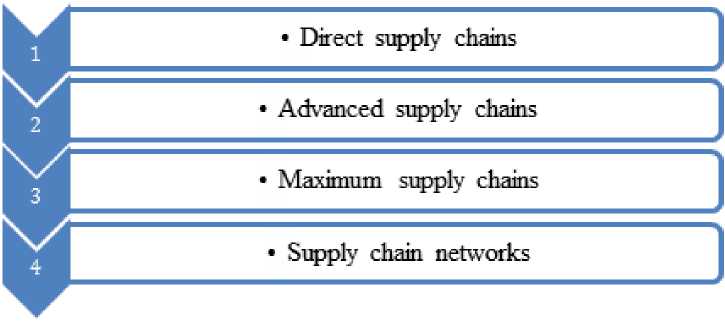
Source: [Scherbakov, Silkina, 2019].
Supply chain development has led to a change in the scale of managerial tasks. Four levels of supply chains are distinguished: direct supply chain, advanced supply chain, maximum supply chain and supply chain networks. Currently, there is a transition from maximum supply chains (supply chain 3.0), consisting of a company and all interested parties, to intelligent supply chains (Scherbakov, Silkina, 2019). This transition is largely due to a change in the structure of needs and expectations of customers. It also updates the digitalization of logistics networks as part of the development of global supply chains.
The role of international transport corridors (ITC) is growing, since the creation of a unified ITC system means the formation of an integrated economic space that allows optimizing a number of procedures that accompany the passage of goods across borders and ensuring the integration of national economies into the world economy.
In the framework of the formation of a unified transport and communication infrastructure of the ITC, commodity circulation between Europe and the countries of the AsiaPacific Region (APR), in particular the EU-China transport link, is actively discussed. The priority for both parties is the creation of such routes that would minimize the delivery time of products and transportation costs. It is known that Russia occupies most of the Eurasian continent, which means that its role in the consolidation of integration initiatives to build the ITC linking the European countries and China is quite large. In West-East freight traffic Russia acts as a transit country with enormous potential due to its favorable geopolitical position. Therefore, the implementation of projects of a transport and economic nature will greatly contribute to consolidating the status of an international logistics hub for the Russian Federation and its active foreign economic development.
The purpose of this study is to determine the influence of stakeholder interests on the development of transport infrastructure, taking into account the digitalization trend of the logistics network.
The logic of the study is as follows:
The study is devoted to the development of an approach to the formation of options for realizing the logistic potential of Russia, which can be evaluated according to certain criteria that satisfy the interests of stakeholders, and systematized in accordance with the degree of digitalization of global supply chains.
The options for transporting goods from China to the EU as formulated by the authors:
1) transportation based on the US proposals without the participation of EAEU;
2) The Maritime Silk Road;
3) through Kazakhstan without using the logistics infrastructure of Russia;
4) through Russia using its logistic capacities without the participation of Kazakhstan;
5) with the participation of Russia and Kazakhstan.
The innovative nature of the modern model of economic development actualizes the search for new factors of economic dynamics, one of the important components of which is the possibility of integration, coordination and cooperation of network interaction of business processes [Dunayev, 2016].
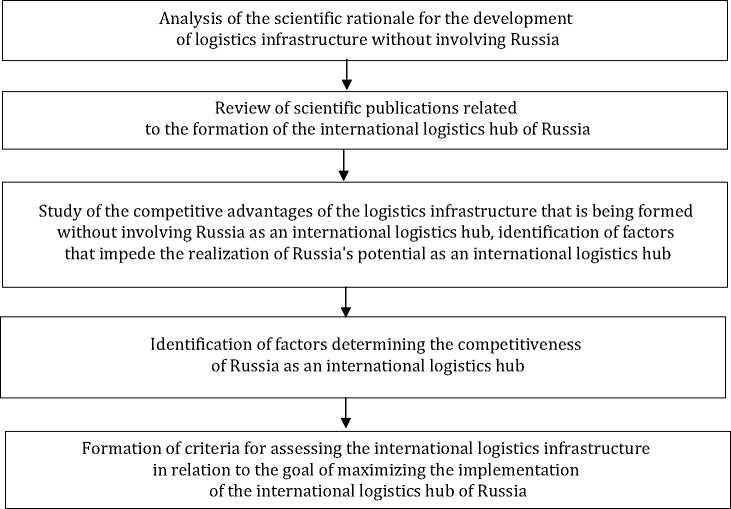
Thanks to the building of a transport and logistics complex it is possible to achieve an integration of economic entities into the global system of production and distribution of goods. At the moment the pace of integration into the global trading system depends not only on maintaining an open global economic system, but also on the quality and effectiveness of supporting structures, which include logistics and supply chain management [Gani, 2017].
Within the general trend of globalization Industry 4.0 is emerging, which is also reflected in the development of logistics and global supply chains. Due to the growing importance in the global economy, logistics is becoming a significant digitalization practice, since this area of activity penetrates all economic areas and is involved in building customer-oriented networks of manufacturers, suppliers and providers of logistics services [Silkina, 2019].
Globalized supply chains manage a complex network of relationships and flows, since the digitization of supplies has made it possible for the value-added chain to access, store and process large amounts of information and, therefore, increase the accuracy of forecasting and decision-making related to the transportation of goods. The logistics of supply chains is being rebuilt into network logistics – a transition from linear sequential chain interactions of participating entities to a combination of chains and the construction of structures with feedbacks [Larin, 2017]. In the face of ongoing changes the logistics system must rely on a solid digital foundation in order to remain competitive in the market. A digital platform is a system of mutually beneficial relations of a significant number of interested market participants carried out in a single information environment leading to lower transaction costs through the use of a package of digital data processing technologies and changes in the system of labor division2.
At this stage of development digital platforms are the main element that forms a single digital space of the transport complex and realizes the country's transport and logistics potential. The digital platform provides reliability, availability, safety and quality of the transport complex3.
The modular structure of the platform allows users to add their own nodes or expand the functionality of the existing ones. Nodes interact using IoT technology while blockchain technology is used to record agreements and complete transactions, as well as a reliable public list of services and information. The Blockchain technology connects nodes into an accessible and secure system that provides reliable services of supply chains [Rozman, 2018].
The formation of digital platforms, in turn, actualizes the development of the omnichannel concept, which consists in using different channels for interaction of all participants in a particular business process. The growth of multichannel trade has a direct impact on logistics and supply chains.
Building a structured multi-channel supply chain can be effective both from an economic point of view and as part of satisfying customers’ requests. The interaction between stakeholders is carried out in a system of three key elements: information, products and resources. Using different channels for each flow helps classify the components of omnichannel trading. A successful supply chain should manage the flow of information, resources and products to create value for customers [Chopra, 2018].
In the conditions of multichannel trading it is logistical rather than trading conditions that are of paramount importance considering, first of all, timely deliveries. It should be noted that in the transition to multi-channel approach logistics:
1) ensures cost reduction through outsourcing;
2) acts as a relevant part of the commodity-service relationship between the supplier and the client through “to the day” and “last mile” deliveries;
3) ensures ongoing development as it assumes part of the marketing competencies [Mikhaylyuk, 2017].
In addition, in a multi-channel logistics system the following problems are distinguished: inconsistent intensity of consumption, reduced competencies in forecasting demand, requirements to lower prices, to change volumes and delivery times. [Gasparyan, 2015].
2. RESEARCH METHODOLOGY
Modern supply chains are a system of interacting material and information flows. Managing these flows is a key task in ensuring the functioning of the logistics system as a whole, which occurs through coordination and establishment of cooperation between partners, which may be suppliers, intermediaries, third-party service providers or end customers [Bowersox, Kloss, 2005].
Logistics is considered as a coordinating component of the material and information supply flows in order to satisfy consumer demand. A supply chain is a pool of partners who jointly convert a product into a finished product that is evaluated by the consumer [Smart, Harrison, 2002].
Improved logistics has a greater impact on trade stimulation than tariff reductions: logistics costs affect trade costs more than tariff barriers in most countries. The trend of consolidation of production and stocks has led to the situation when instead of a large number of distribution centers on the way of cargo flows from the producer to the final consumer, integrated logistics platforms appear, which can minimize logistics costs and the total time of cycle distribution. The internationalization of logistics is changing priorities in the cargo transportation system: physical distance is becoming less important even for large products. The question is how to reconfigure international logistics networks [Smart, Harrison, 2002].
Alan Harrison and Alan Smart identified key indicators and related elements that are characteristic for the reconfiguration of global chains (Table 1).
Table 1.
Key indicators of reconfiguration of global networks
Source: [Smart, Harrison, 2002].
In recent years, there has been an active building of logistics and distribution centers, warehouses and terminals. However, the pace of development of large infrastructure facilities does not correspond to the pace of development of industrial production centers, industrial parks and complexes, as well as economic zones [Mikhaylyuk, 2017].
To select the best option for the transportation of goods maximally realizing the transport potential of Russia the authors took as a basis the approach of Harrison, which makes it possible to develop a methodology for assessing the interests of stakeholders of the country's international logistics hub.
Harrison and Smart propose to reconfigure networks from local distribution through logistic centralization to deferred production highlighting four stages of implementation of deferred production through the formation of global starting points:
- direct export;
- national warehouses;
- logistics centralization;
- deferred production.
Figures 3‑6 show the main criteria by which freight transportation options can be evaluated: speed, reliability, time, and development of digital platforms.
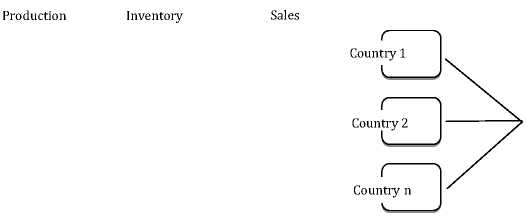
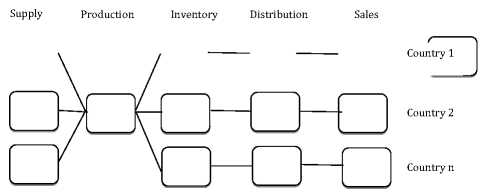
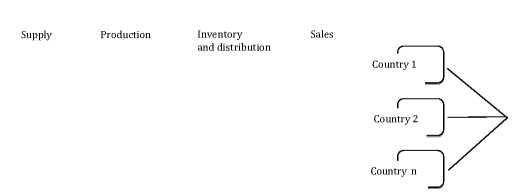
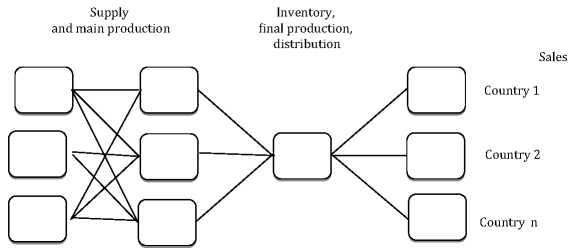
In the context of this study reliability is considered as a key quality factor that accurately characterizes the assessment of the availability and functionality of the logistics system and determines its ability to serve consumers at the proper level. The reliability of transportation is simultaneously affected by speed, (speed depends on the type of transport and method of transportation), cost (at a low cost of transportation general costs are reduced), the presence of digital platforms that can positively affect reliability.
The cost of transportation of goods is a sum of the costs of moving the goods, the management of inventory and their maintenance. The logistics system should be organized in such a way that its total costs remain at a minimum level. Moreover, the use of the cheapest means of transportation does not mean a decrease in costs, because in this case the attention is more focused on reliability [Daganzo, 2005]. It is possible to reduce the cost of transportation not only using cheap labor or materials, but also through the introduction of digital technologies that will not change or even improve its reliability.
The next criterion is the speed of transportation. This criterion is characterized by the time necessary for the full implementation of the transportation of products. With an increase in delivery speed the price also rises in most cases. Therefore, it is important to strike a balance between speed and costs.
Based on the cost and time of cargo transportation, alternative options for moving goods are formed, which allows the customer to select in accordance with the criteria of interest to him [Bowersox, Kloss, 2005].
Before proceeding with an analysis of the available options for the delivery of goods and choosing the most suitable one, it is necessary to analyze the role of stakeholders in the formation of transnational supply chains within the considered routes, as well as the degree of their interest and involvement in the implementation of the idea presented in the hypothesis.
The formation of a specific route can be considered from the point of view of the implemented project taking into account the needs of all interested parties. One of the most widely used definitions of stakeholders is that an interested party is a person or group of people whose interests are influenced by the results of the project and who have the right to influence the results of the project. Consequently, within the supply chain stakeholder interests will be determined by the economic benefits derived from using one of the transportation routes [Walker et al., 2008].
According to the theory of instrumental stakeholders, stakeholders are identified based on their capabilities or influence factors. Stakeholders interact with participants in the supply chain through negotiations, which can vary from confrontation to mutual adaptation depending on such intermediate variables as trust, commitment and motivating forces [Donaldson, Preston, 1995].
To analyze the influence of stakeholder interests, we considered the convergence theory of Jones and Weeks, which implies that the actions of stakeholders and their reaction to changes in supply chains lead to the situation when the key participants, namely, the sending and receiving countries, should develop mutual trust and collaborative relationships with stakeholders.
Consequently, their actions should be based on ethical standards. Such interaction within the framework of transportation is consistent with the principles of 3PL (Third party logistics), in which the success of activity is determined in compliance with financial performance indicators, as well as indicators of environmental and social responsibility [Elkington, 1997].
Therefore, the identification of stakeholders is an important component in deciding on the choice of a route for the movement of freight flows, because based on their interests and the identified potential impact on the development of the selected route, appropriate strategies are formulated to maximize the positive impact and minimize the negative one. This, in turn, makes it possible to avoid negative effects of the supply chain’s functioning [Walker et al., 2008].
Based on the classification [Morris, Hough, 1993], four groups of stakeholders can be distinguished, each of which can include a number of participants: a client or a recipient country, a producer country, third-party services, invisible participants in the supply chain. Cleland recognized the need to develop an organizational structure for stakeholders by exploring the interests of each of them and negotiating individually and collectively to determine the best way to manage stakeholder needs. He identifies two groups of stakeholders in the supply chain: asset holders and those with an interest [Cleland, 1995].
Based on the classification [Morris, Hough, 1993] four groups of stakeholders can be distinguished, each of which can include a number of participants: a client or a recipient country, a producer country, third-party services, invisible participants in the supply chain. Cleland recognized the need to develop an organizational structure for stakeholders by exploring the interests of each of them and negotiating individually and collectively to determine the best way to manage stakeholder needs. He identifies two groups of stakeholders in the supply chain: asset holders and those with an interest [Cleland, 1995].
The classification of stakeholders into certain groups led to the concept of an analytical circle of stakeholders, the main idea of which is that the implementation of the project is possible only with the full consent of its interested parties regarding the choice of the route. The analytical circle simultaneously acts as a methodology for stakeholder management and as a software tool for assessing the significance of each participant [Walker et al., 2008].
Therefore, stakeholders form a circle consisting of:
1) definitions of stakeholders – at this stage stakeholders are identified, which are divided into groups in accordance with the degree of their influence on the project;
2) prioritization – the priorities of stakeholders are considered from the point of view of three factors of significance: power (its importance or limitation), proximity (distance from the core of the project) and urgency (willingness of these stakeholders to do anything to achieve the goals of the project). Assessments are made by experts on a scale from 1 to 4, where 1 is a relatively low level, 4 is a relatively high level;
3) visualization – the data of the previous stages are visualized in the scheme of stakeholders;
4) involvement – this stage is based on the identification of approaches to the interaction of parties taking into account their expectations and needs. One compiles a list of stakeholders defined as the most important and influential for the project. They should receive special attention from the specialists involved in the project, however, interaction strategies for all stakeholders should be developed. The first stage of this analysis is to determine the level of interest from the critical (5 points) to ontological (1 point). Further, also on a fivepoint scale, an analysis of susceptibility of participants is carried out, after which matrices are built that reflect the effectiveness of interaction of stakeholders. The final stage is the formation of a communication plan that describes the forms of communication between stakeholders. Each detail is indicated: type of message, time, length, device from which to send messages and to which the message should arrive, as well as its sender;
5) control – after the development of a communications plan the main dates of interaction are included in the project and negotiated at official meetings and sessions [Walker et al., 2008].
The combination of these elements forms a group of stakeholders, which can be graphically represented as a kind of circle of participants. This approach to reflection was proposed by P. Weaver and L. Born to demonstrate the relationship of stakeholders and their relationship with each other. The distance of stakeholders from the object of implementation is shown by geometric markings inside the circle of interested parties. The size of the inner circle reflects the degree of influence of the interested person, and the designations and colors of the circles reflect the direction of influence of certain stakeholders on the object of implementation.
3. RESULTS
Based on the analytical circle of stakeholders (Fig. 7), the authors of this article propose their own version taking into account different interests of stakeholders involved in the formation of supply chains for the transportation of goods from China to the EU (Fig. 8).
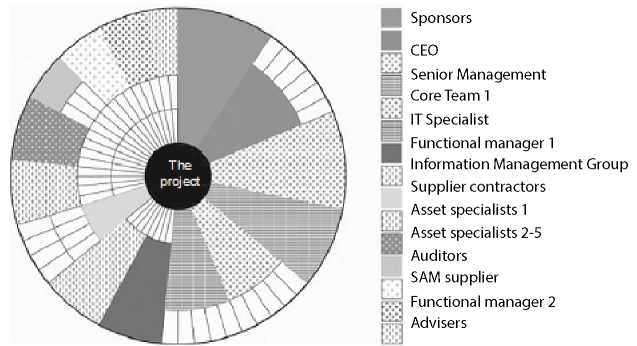
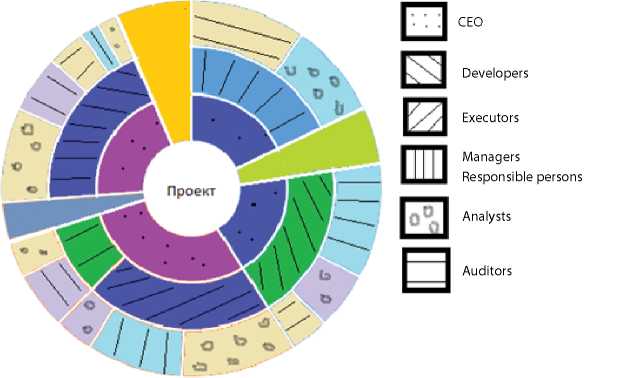
Dark shades, such as purple, blue or green, highlight persons, which are more likely to affect the target: CEOs, managers and decision makers, developers, executors. Those stakeholders whose influence has a lesser degree of significance (analysts and auditors) are highlighted in lighter shades.
End users have a great influence on the choice of route. This group includes primarily the state. This influence is explained by the fact that the project of implementation of a logistics hub based in Russia is international, large-scale and requires considerable investments. The initiative’s implementation will make global changes in the infrastructure and change the competitive position of partner states in the transportation of goods from China. Probably, not all competitive routes will recede into the background; some of them, on the contrary, will work hard to strengthen their positions. Therefore, their influence is also significant in the implementation of the project.
As it is known, most routes pass through the territory of Central Asia, which makes this region strategically attractive for three key players – Russia, China and the United States. The authors of this article have prepared an extensive review of scientific publications related to the formation of an international logistics hub in Russia.
Due to historical and geographical facts that have a noneconomic basis, China and Russia have fairly strong ties with the countries of Central Asia. However, the United States has a great potential (significant financial resources, great political and military influence) to strengthen its position in this region.
An active participation of the United States in the economic development of Central Asia is now also caused by the rapid economic penetration of China into this region and the interests of Russia in realizing its transport and logistics potential. The main target for the USA is the isolation of Russia from the post-Soviet space by building trade routes bypassing the Russian Federation. At the same time, China has an ambiguous position: according to Frederick Starr, one of the chairmen of the American Council on Foreign Policy, Chinese investments in the Silk Road Economic Belt (hereinafter referred to as the SREB) can provide significant assistance in realizing this idea [Gasparyan, 2015].
There are different points of view regarding the relations between the EAEU and China in the framework of the latter's implementation of the Silk Road Economic Belt project, including the problems and prospects for cooperation between China and Russia. China seeks to build up the economic influence of the New Silk Road, in which Russia can help because of its favorable geopolitical and geoeconomic position on the mainland. In general, the Chinese vision of its initiative in relation to Russia and the EAEU is manifested in several positions:
1) Russia and the EAEU are considered as one of the corridors of the new route, which offers the shortest way to the unified customs area;
2) from the political point of view, the EAEU can become a “mediator” of China in its economic presence on the postSoviet territory;
3) harmonization of projects developed by China and Russia for subsequent economic cooperation.
The Government of Kazakhstan also considers its participation in the development of the New Silk Road as an opportunity to reduce its dependence on the Russian economy4.
Based on the prospects of cooperation, a large share of trade between China and Europe could potentially go through Kazakhstan, which means the halving of transportation time. Of course, this fact makes it possible to evaluate the future business of the countries of Central Asia, as it provides great opportunities for capitalization of the existing and new trade routes. It is planned that by 2022 the size of investments will be about 700 billion US dollars [Dunayev, 2016].
The strategy of economic development of Kazakhstan is very similar to the concept of Russia, since it also considers energy, transport and industry as the key connecting links. Kazakhstan also has a geographical advantage and defines its potential as a strategic bridge between Europe and Asia. Of course, this opens up great opportunities for trade and investment with China. In 2015, agreements worth 23,6 billion US dollars were signed in the automotive, hydropower, metallurgical and oil refining industries5.
Investments in the development of Kazakhstan as one of the important transit corridors within the concept of the “New Silk Road”, implemented under the slogan “One belt – one way”, have already shown results in strengthening its market position. According to KTZh and McKinsey Company, the volume of transit container traffic in the direction Asia – Europe – Asia through Kazakhstan will amount to 1700 thousand tenge [Dunayev, 2016].
In the modern economy, the importance and role of transport logistics as one of the most profitable areas of national economies is rapidly increasing. Today, the transport logistics market is estimated at 3,1 trillion US dollars, which is more than 7 % of the global GDP. Clearly, the development of this sector is among the most relevant, since this industry constitutes a significant part of the national income [Sultanov et al., 2019].
At the same time, in the conditions of development of the logistics services market there is a decrease in the level of logistics systems due to the unification of large players and the introduction of multi-channel and omnichannel concepts, while the multi-channel logistics arises from the concept of integrated logistics and its multi-stage nature.
In other words, the logistics system is multi-channel, because, despite the decrease in the number of links in the chain, the number of stages in the transportation of goods increases due to the implementation of fulfillment operators and their outsourcing operators [Mikhaylyuk, 2016].
When choosing a route along the Trans-Siberian Railway the transportation of containers with goods will last from 20 to 35 days, depending on the chosen corridor (Far Eastern or Central Asian). The cost of transportation by rail from China to Europe is on average 8-9 thousand US dollars with the price formed from transportation of goods to industrial areas of China and from the Far East to the European part of Russia. The advantage of the Trans-Siberian Railway over sea transportation is the absence of transshipment costs and ferry crossings. However, now the Transsiberian railway cannot cope with the current load as the speed of transportation along the highway is on average 11,5 km / h. This is related to the congestion of the railway, therefore, in order for the transportation through Russia to be competitive, it is necessary not only to reduce tariff prices and simplify customs procedures, but also to improve the infrastructure in order to be able to offer an alternative6.

TRACECA (Fig. 10) can be called a competitive way built to bypass Russia when delivering goods from China to the EU. This corridor connects Asia, the Caucasus and Europe. Therefore, China can send goods through Kazakhstan. This corridor is part of the Silk Wind route proposed by Kazakhstan and transporting goods through Georgia (Fig. 11). “Silk wind” in comparison with sea transportation from China reduces the time from 40-45 days to 10-15 days.


Its disadvantage is that transshipment will need to be carried out in four ports, which will increase the cost of transportation several-fold. The disadvantages also include its underdeveloped infrastructure and the shortage of ferries to fully load the route. In addition, on the Silk Wind route the number of containers in a train was less than that of competitors: the first train launched from China through Georgia to Turkey had 21 containers, while the average number of containers on the Trans-Siberian trains was 80.
The transportation from China can be carried out through the Druzhba station in Kazakhstan and further to Russia, which is shorter than through the Trans-Siberian Railway. However, despite the reduction in time and costs there is a problem of undeveloped infrastructure (a small number of terminals, the risk of robbery). With this transportation, the cost is 10 thousand dollars per container, and the delivery time to Russia is from 10 days7.
The transportation from China through the Suez Canal to Moscow on average takes 40 days, while the cost of transportation of one container is 4,5 thousand US dollars.
A strong competitor to land transportation through Russia is the Maritime Silk Road (MSR) (Fig. 12).




The cost of transportation by sea is much lower. On average it is 3 thousand US dollars per container. Considering that the main criterion during transportation is the safety of goods, and not the speed of delivery, the use of sea transport has an advantage due to the high level of cargo safety during transportation. Therefore, with an average delivery time of 40‑45 days by Maritime Silk Road it will be more profitable for the customer.
Table 2
Types of risks of investing in the infrastructure of the Northern Sea Route

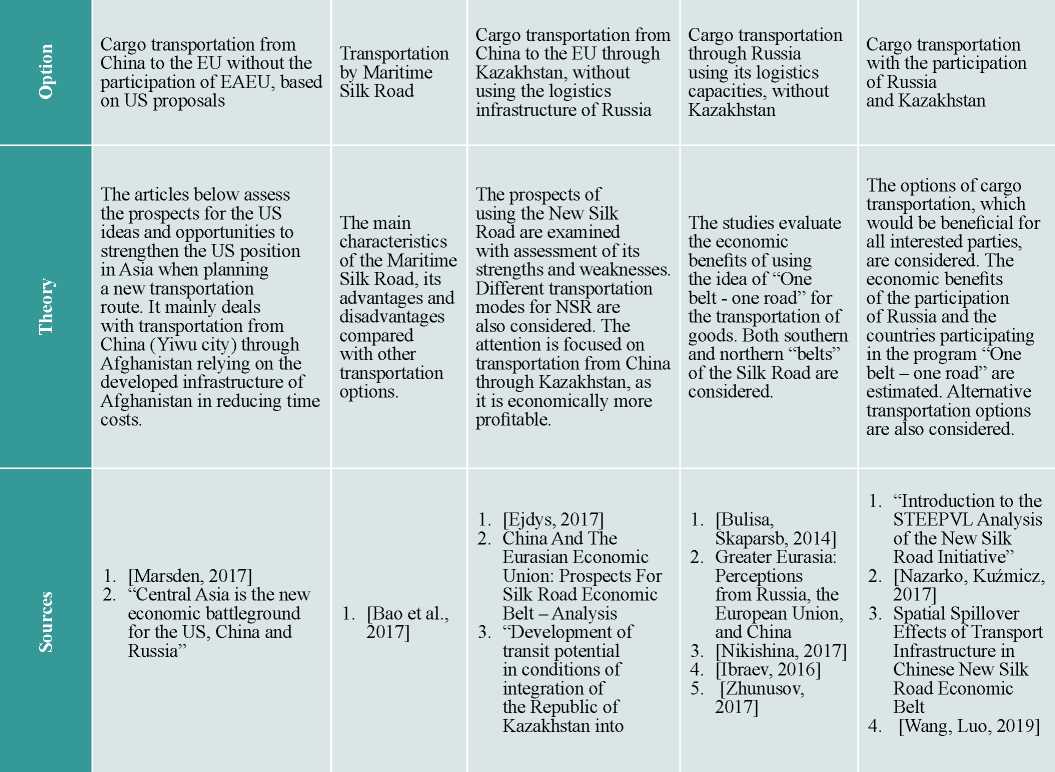
In recent years the interest in commercial shipping along the Northern Sea Route (NSR) has grown significantly – both among the Arctic and non-Arctic countries. The main reason is associated with the retreat of ice in the Arctic Sea, which creates opportunities for the use of a viable sea route for shipping and trade. The reduction of length of the regular sea route through the Panama or Suez Canals reduces costs and time.
Despite a number of barriers to the development of the Northern Sea Route, including climatic conditions, high tariff rates, difficulties with the customs clearance of goods, over the past few decades China has shown an increasing interest in the development of this route. According to the forecast of the Chinese Polar Research Institute, by 2020 up to 15 % of China's international trade can be carried out through the Northern Sea Route [Stepanova, Sivobrova, 2016].
The cooperation with Russia in developing the Northern Sea Route can give China almost all the benefits it seeks from participation in Arctic affairs, namely: access to raw materials, development of national ports and diversification of sea routes.
In September 2013 China's representative Xi Jinping introduced the One Belt – One Road initiative, which includes the Silk Road Economic Belt and the Maritime Silk Road [Tsvyk, 2018]. To implement the SREB project it is necessary to create a railway, transport and pipeline infrastructure, which will subsequently lead to free trade between the Eurasian and Asian parts of the mainland and strengthen the political relations of partner countries. The essence of the SREB project is to create three trans-European corridors.
The delivery time by the SREB through the Southern Corridor is longer than along the Trans-Siberian Railway. Moreover, the problem of crossing a large number of borders is also significant.
The northern SREB corridor, which passes both through the territory of Russia and Kazakhstan, is a more profitable option for both Russia and China. The main advantage of the Northern Corridor is that its length is 1000 km less than the Trans-Siberian Railway, and the cost of transporting goods is lower.
Therefore, the Silk Road Economic Belt can be considered a connecting link, since it allows for a more favorable way to combine the previously listed transportation options from China to the EU, since it includes a significant part of the infrastructure facilities of the participating countries and combines logistics routes and corridors.
As noted earlier, the criteria by which routes will be evaluated in this work are reliability, time, cost and development of digital platforms. When ranking the criteria, the most important one, according to the authors, was the reliability criterion, since the success of transportation as a whole depends on it. It also affects other criteria. It is followed by the time criterion, since the distance between countries can be significant, which directly affects transportation.
The cost of transportation largely depends on the choice of route, since it is affected by customs duties and the choice of transport. The least important is the development of digital platforms, as digitalization is just beginning to become important for the participants in supply chains.
In conducting pairwise comparisons of the criteria the matrix was built on the basis of the Thomas Saati method, in which the ratings were set by the authors taking into account the previously formed circle of stakeholders and their interests in accordance with the intensity scale also proposed by Saati. An indicator of random consistency was introduced into the calculations based on the fact that the estimates were set randomly.
A comparison of options relative to the selected criteria was made. Options with the most advanced digital platforms are the route through Afghanistan proposed by the USA and the Maritime Silk Road. The most cost-effective route was the one involving logistics capacities of Russia and Kazakhstan. The fastest transportation is via Russia and Kazakhstan or bypassing Kazakhstan through Russia. The most reliable is also transportation carried out with the cooperation of Russia and Kazakhstan, or with the participation only of Kazakhstan.
In addition, an assessment of criteria regarding the degree of their significance for stakeholders of specific routes was made. As a result, we built a hierarchy for each transportation option, reflecting the role of the criteria from the most important to the least important in ensuring transportation. The results are presented in table 4.
Table 4
The hierarchy of significance of criteria for each of the analyzed routes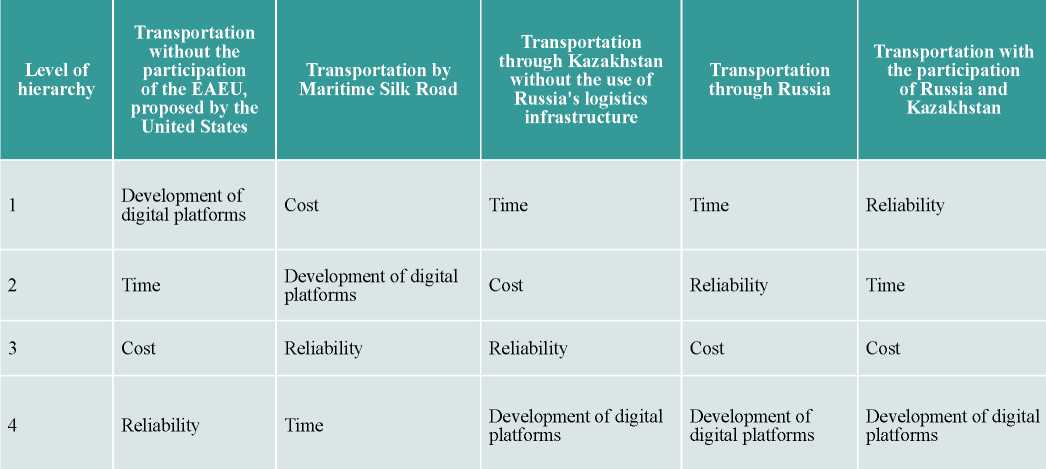
Based on the general importance of priorities, the best option for stakeholders was the route for transporting goods from China to the EU while using the logistics capacities of Russia and Kazakhstan.
4. DISCUSSION AND CONCLUSION
A comparison of the criteria with each other, as well as an assessment of their impact on transportation in each option showed how diverse the interests of stakeholders in the supply chain are. Certainly, the selected routes have an individual set of criteria that have varying degrees of manifestation during the transportation of goods. Since the routes satisfy the economic interests and needs of different stakeholders it is advisable to consider whether these interests can coincide and with respect to which objects they can be combined.
Due to the fact that the study was carried out on the basis of information about the criteria and taking into account the interests of only those stakeholders who were included in the analytical circle as the most important ones in the formation of supply chains, the question remains open about the influence and impact of criteria not considered in the article, and the interested parties to choose the optimal route in the framework of the hypothesis.
In carrying out the study the interests of the international economy and political relations of the participating countries were not taken into account while the main attention was paid to the development of the logistics infrastructure and its characteristic features. It should be noted that the assessment of criteria by stakeholders may be subjective.
There is a socio-psychological aspect, which may also affect the choice and assessment of the route. It is necessary to take into account the fact that customers already have their own vision of transporting goods from China to the EU (via the Suez Canal or the Trans-Siberian Railway) and, despite the “One Belt – One Road” initiative it is not easy for the participants in cargo transportation to adapt to new concepts even with significant economic benefits.
There is also a technological problem, which is the modernization of logistics systems on each of the selected routes. As it has been noted, many of them have a problem of non-compliance with the requirements of modern society. At the same time, individual countries have programs involving investments in the development of corridors, but the implementation dates often come to an end before modernization is completed. This demonstrates the problem of investments and lack of funds to make routes competitive in the market not only due to the advantageous position of countries through which a specific route passes.
Despite a number of barriers such as subjective opinion, social peculiarities of route selection, technological aspects of supply chains, interests of stakeholders can be systematized. Since the choice of a particular route by the participating countries is based on the maximum realization of the transport and economic potential of the regions through which the supply chain will go, it can be assumed that the development of the logistics system as a whole can be achieved by attracting third-party stakeholders whose interests are aimed at other economic entities.
A pairwise comparison of the criteria showed that the main factor in the transportation of goods using Russia's capacities is time. This criterion plays a significant role in choosing a route, however, in case of high costs and insufficient reliability, such a route will in most cases be inferior to alternative ones. Consequently, the attraction of opportunities and advantages that other options can provide, becomes quite appropriate for interested parties. Therefore, the harmonization of relations between stakeholders is reduced to combining their interests regarding the selected transportation options for the development of Russia as an international logistics hub and to show what economic benefits they can get from this interaction.
1. Digital platform of the transport complex // DTLA. URL: https://www.dtla.ru/projects/ (access date: 10.25.19).
2. Approaches to the definition and typification of digital platforms. URL: https://files.data-economy.ru/digital_platforms_project.pdf (access date: 26.10.2019).
3. Digital platform of the transport complex // DTLA. URL: https://www.dtla.ru/projects/ (access date: 25.10.19).
4. China and the Eurasian Economic Union: Prospects for Silk Road Economic Belt-Analysis. URL: https://www.eurasiareview.com (access date: 26.10.2019).
5. In same place.
6. China bypasses Russia // Gazeta.ru. URL: https://www.gazeta.ru/business/2015/12/27/7995287.shtml?updated (date of access: 16.10.2019).
7. Ways of delivery of goods from China // Galaxylogistics. URL: http://www.galaxylogistics.ru/analitika/puti-dostavki-gruza-iz-kitaya.html (Date of access: 16.10.2019)
References
1. Bauersoks D.J., Kloss D.J. (2005). Logistika: integrirovannaya tsep’ postavok. Moscow, Olimp-biznes, 51–66.
2. Valovaya T. (2016). Sopryazhenie Ekonomicheskogo poyasa Shelkovogo puti s EAES mozhet posluzhit’ sozdaniyu vseob’’emlyushchego evraziyskogo ekonomicheskogo partnerstva na kontinente. Eurasiancommission. URL: http://www.eurasiancommission.org/ru/nae/news/Pages/27-06-2016-1.aspx (date of access: 24.10.2019).
3. Vinokurov E.Yu. (2018). Transportnye koridory Shelkovogo puti: potentsial rosta gruzopotokov cherez EAES. Saint Petersburg, TsII EABR.
4. Gasparyan V. (2015). Omnikanal’nyy riteyl v Rossii: mify i real’nost’. Retail&Loyalty, 7(52).
5. Dunaev O.N. (2016). Trans-Evroaziatskaya logisticheskaya platforma: praktika, produkty, rynki. Moskva, TPP RF.
6. Zhunusov A. (2017). Integratsiya napravlena na snizhenie izderzhek biznesa po transportirovke tovarov. Eurasiancommission. URL: http://www.eurasiancommission.org/ru/nae/news/Pages/15-06-2017-1.aspx (date of access: 19.10.2019).
7. Ibraev D. (2016). Shelkovyy Put’ nachinaetsya s pervogo shaga. Vecherniy Bishkek. Eurasiancommission. URL: http://www.eurasiancommission.org/ru/nae/news/Pages/08-06-2016-7.aspx (date of access: 20.10.2019).
8. Larin O. (2017). Perspektivy integratsii transportnykh sistem Evraziyskogo ekonomicheskogo soyuza. Problemy natsional’noy strategii, 4(43), 152.
9. Malyshev S. (2017). Pochta Rossii: my ostaemsya igrokom № 1 dazhe s uchetom konsolidatsii konkurentov. Retail&Loyalty, 3(66), 31.
10. Mikhaylyuk M.V. (2016). Perspektivnye napravleniya i osobennosti razvitiya tsepey postavok mnogokanal’nogo riteyla na potrebitel’skom rynke. Ekonomicheskie nauki, 11, 34–35.
11. Mikhaylyuk M.V. (2017). Fulfilment kak relevantnoe logisticheskoe zveno mnogokanal’noy tsepi postavok potrebitel’skogo rynka. Modern Economy Success, 6, 211–213.
12. Nikishina V. (2017). EAES i «Shelkovyy put’» – ne konkurenty, a partnery. Eurasiancommission. URL: http://www.eurasiancommission.org/ru/nae/news/Pages/12-09-2017-V.aspx (date of access: 19.10.2019).
13. Sidorskiy S. (2018). Bol’shoe Evraziyskoe partnerstvo vokrug yadra EAES–Kitay – effektivnyy otvet na vyzovy v mirovoy ekonomike. Eurasiancommission. URL: http://www.eurasiancommission.org/ru/nae/news/Pages/4-07-2018-2.aspx (date of access: 20.10.2019).
14. Silkina G.Yu. (2019). Sovremennye trendy tsifrovizatsii logistiki: monografiya. Saint Petersburg, Politekh-Press.
15. Stepanova V.V., Sivobrova I.A. (2016). Problemy razvitiya Severnogo morskogo puti Arktika i Sever, 22, 88.
16. Bao J., Jian L., Chunxia G. (2018). Maritime shipping and export trade on Maritime Silk Road. Elsevier, 34(2), 83–90.
17. Bao J., Jian L., Jiangxue W. (2017). Spatial spillover effects of transport infrastructure in Chinese New silk road economic belt. International Journal of e-Navigation and Maritime Economy, 6, 17–22.
18. Bulisa A., Skaparsb R. (2014). Development of “New Silk Road”. Northern branch through seaport of Riga in Latvia. Elsevier, 10, 1222–1229.
19. Chopra S. (2018). The evolution of omni-channel retailing and its impact of supply chains. Transportation Research Procedia, 30, 4–13.
20. Cleland D.I. (1995). Leadership and the project management body of knowledge. International Journal of Project Management, 13(2), 82–88.
21. Daganzo C. F. (2005). Logistics systems analysis. California: Springer. P. 15–42.
22. Donaldson T., Preston L.E. (1995). The stakeholder theory of the corporation: concepts, evidence, and implications. Academy of Management Review, 20(1), 65–91.
23. Elkington J. (1997). Cannibals with forks. Capstone, Oxford, Capstone Publishing.
24. Ejdys J. (2017). New Silk Road – a weak or a strong signal? Elsevier, 8, 182–188.
25. Gani A. (2017). The logistics performance effect of international trade. The Asian Journal of Shipping and Logistics, 33(4), 279–288.
26. Ghiani G., Laporte G., Musmanno R. (2013). Introduction to logistics systems management. John Wiley & Sons. P. 480.
27. Marsden M. (2017). Actually exiting silk roads. Journal of Eurasian Studies, 8, 5–59.
28. Monczka R., Handfield R., Giunipero L., Patterson J. (2008). Purchasing and supply chain management. Cengage learning. The University of New South Wales, Sidney, Australia.
29. Morris P.W.G., Hough G.H. (1993). The anatomy of major projects – a study of the reality of project management. London: Wiley.
30. Nazarko J., Kuźmicz K.A. (2017). Introduction to the STEEPVL. Analysis of the New Silk Road initiative. Elsevier, 7, 22–30.
31. Rozman N., Vrabic R., Corn M., Pozrl T., Diaci J. (2018). Distributed logistics platform based of blockchain and Iot. Procedia CIRP, 81, 826–831.
32. Scherbakov V., Silkina G. (2019). Logistics of smart supply chain. International Conference on Digital Transformation in Logistics and Infrastructure.
33. Schniederjans D.G., Gurado C., Khalajhedayati M. (2019). Supply chain digitisation trends: An integration of knowledge management. International Journal of Production Economics, 25, 117–136.
34. Smart A., Harrison A. (2002). Reverse auctions as a support mechanism in flexible supply chains. International Journal of Logistics Research and Applications, 3, 275–284.
35. Sultanov T., Suleimenov T., Tlepiyeva G., Sansyzbajeva Z. (2019). Development of transit potential in conditions of integration of the Republic of Kazakhstan into the world transport system. Procedia Computer Science, 149, 430–435.
36. Tsvyk A.V. (2018). “Greater Europe” or “Greater Eurasia”? In search of new ideas for the Eurasian integration. RUDN Journal of Sociology, 2, 262–270.
37. Walker D.H.T., Bourne L., Rowlinson S. (2008). Stakeholders and the supply chain. Research Gade, 1, 70.
38. Wang Q., Luo R. (2019). The mechanism and empirical study of intelligent logistics technology improving the efficiency of logistics industry – taking the “Core Area” of the Silk Road Economic Belt as example. Elsevier, 11, 135–142.
39. Wiederer C. (2018). Logistics Infrastructure along the belt and road initiative economies. Macroeconomics, Trade and Investment, 5, 36–68.
40. Wittke K. (2014). The contribution of stakeholder theory to supply chain management. University of Twente, The Netherlands.
About the Authors
S. E. BarykinRussian Federation
Professor, the Higher school of service and trade, Peter the Greatʼs St. Petersburg polytechnical university.
I. A. Boyko
Russian Federation
Undergraduate, the Higher school of service and trade, Peter the Greatʼs St. Petersburg polytechnical university.
A. V. Zakharenko
Russian Federation
Undergraduate, the Higher school of service and trade, Peter the Greatʼs St. Petersburg polytechnical university.
P. A. Sharapayev
Russian Federation
Graduate student, chair of logistics and management of chains of deliveries, St. Petersburg state economic university.
Review
For citations:
Barykin S.E., Boyko I.A., Zakharenko A.V., Sharapayev P.A. DEVELOPMENT OF METHODICAL APPROACH TO AN ASSESSMENT OF INTERESTS OF STAKEHOLDER SMART SUPPLY CHAINS. Strategic decisions and risk management. 2019;10(4):382-395. https://doi.org/10.17747/2618-947X-2019-4-382-395









































